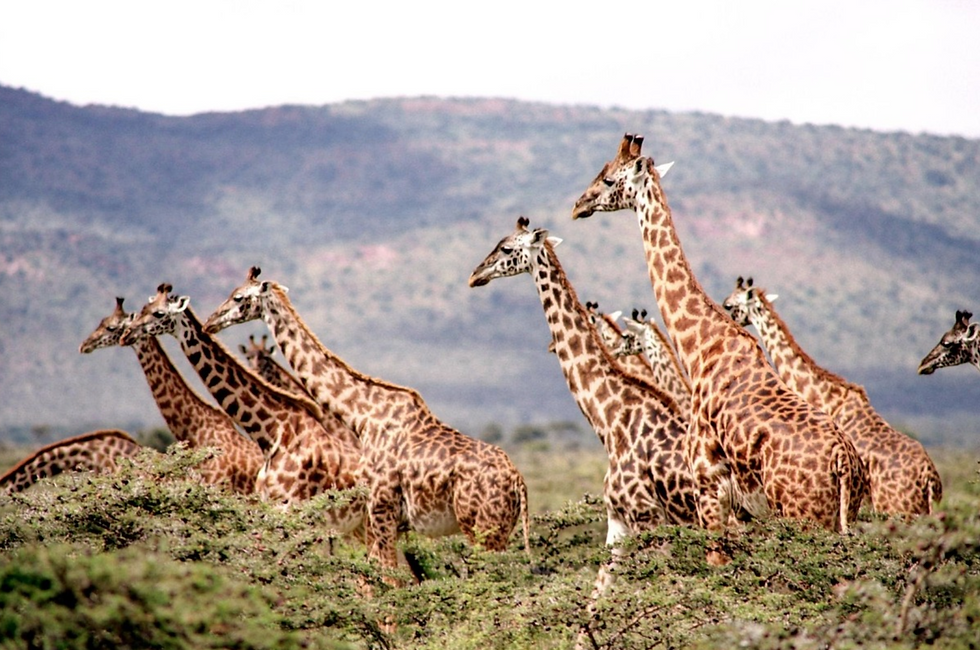Are Giraffes Endangered?
- jessiekdesign
- Feb 27, 2023
- 3 min read
Yes, giraffes are considered to be endangered. Giraffes are classified as vulnerable, which means that their populations are declining and they face a high risk of extinction in the wild. With a 40% decrease in their population over the past three decades, the giraffe is now considered to be endangered, according to the International Union for Conservation of Nature (IUCN).

One of the main threats facing giraffes is habitat loss and fragmentation. Giraffes are native to Africa and they require large areas of savanna and grassland habitats to support their populations. However, as human populations continue to grow, these habitats are being lost and fragmented, reducing the available space for giraffes to roam and find food.
Another threat to giraffes is poaching. Giraffes are hunted for their meat, hides, and tails, which are used for traditional medicine, cultural rituals, and even as good luck charms. This hunting pressure has contributed significantly to the decline in giraffe populations and is a major threat to their survival.

In addition to habitat loss and hunting, giraffes also face several other threats, such as disease, inbreeding, and a lack of genetic diversity. These factors can weaken giraffe populations and make them more vulnerable to other threats, such as predators and environmental changes.
Conservation efforts are underway to protect giraffes and their habitats. These efforts include the creation of protected areas, habitat restoration, and anti-poaching measures. Additionally, efforts are also being made to educate local communities about the importance of giraffes and the need to protect them, as well as to promote sustainable practices that benefit both giraffes and people.

Another important aspect of giraffe conservation is research and monitoring. By studying giraffe populations, scientists can better understand the threats they face and develop strategies to conserve them. This includes monitoring their movements, behavior, and habitat use, as well as monitoring their populations and genetic diversity.
Despite these efforts, giraffes continue to face significant challenges, and their future remains uncertain. It is important that we continue to work together to protect giraffes and their habitats, so that future generations can enjoy the beauty and majesty of these magnificent animals.

To protect these magnificent animals, it is important to understand the various challenges they face and to develop a comprehensive and coordinated approach to conservation. Here are some of the key ways we can help protect giraffes:
Protect and restore habitats: Giraffes require large areas of savanna and grassland habitats to support their populations. By protecting and restoring these habitats, we can provide giraffes with the space they need to roam, find food, and raise their young.
Implement anti-poaching measures: Giraffes are hunted for their meat, hides, and tails, which are used for traditional medicine, cultural rituals, and even as good luck charms. To reduce the impact of hunting, it is important to implement effective anti-poaching measures, such as increased patrols and community-based conservation efforts.
Promote sustainable practices: By promoting sustainable practices, such as sustainable agriculture and eco-tourism, we can help reduce the pressure on giraffe habitats and support the conservation of these amazing animals.
Educate local communities: It is important to educate local communities about the importance of giraffes and the need to protect them. This can include providing information about the threats they face and the benefits of conservation, as well as engaging communities in conservation efforts and decision-making processes.
Support research and monitoring: By supporting research and monitoring of giraffe populations, we can better understand the threats they face and develop strategies to conserve them. This includes monitoring their movements, behavior, and habitat use, as well as monitoring their populations and genetic diversity.
Support international conservation efforts: Giraffes are a shared global resource, and their conservation requires international cooperation and support. This can include supporting conservation organizations, participating in international treaties and agreements, and advocating for giraffe conservation at the national and international levels.

In conclusion, protecting giraffes requires a comprehensive and coordinated approach that addresses the various challenges they face. By working together to protect giraffes and their habitats, promoting sustainable practices, educating local communities, and supporting research and monitoring, we can help ensure that these amazing animals will continue to thrive for generations to come.



Comments